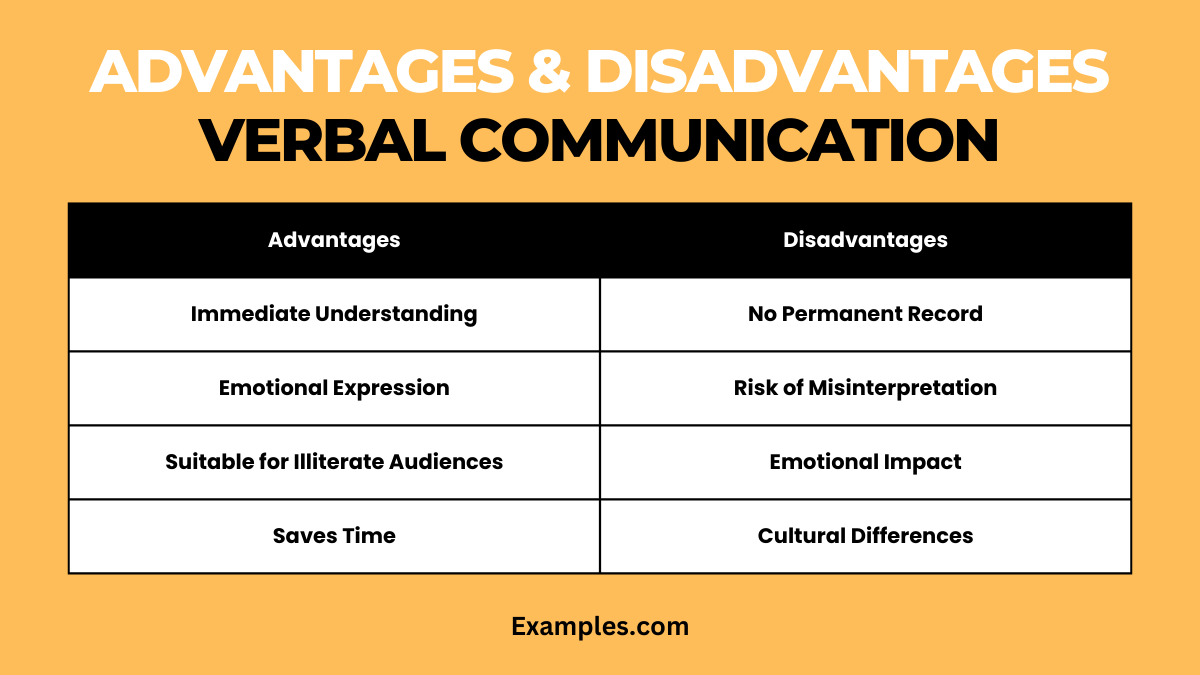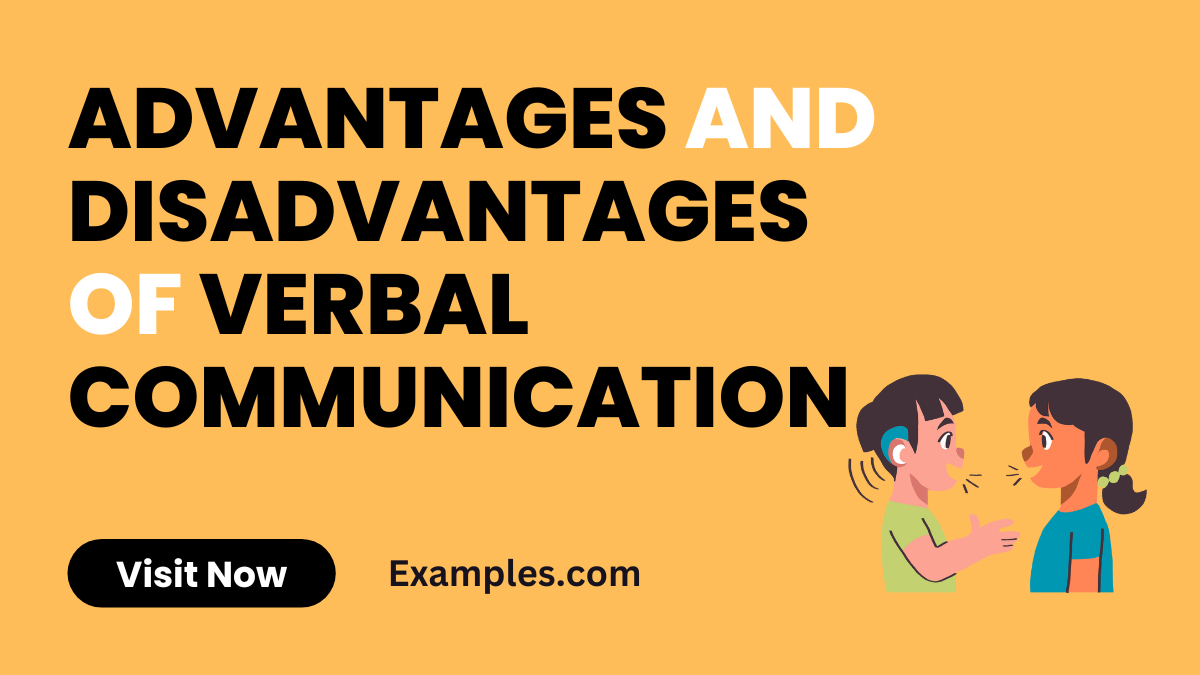Advantages and Disadvantages of Verbal Communication
Embark on a detailed exploration of the Advantages and Disadvantages of Verbal Communication through this guide, brimming with insightful Communication Examples. Discover how verbal interactions can foster immediate understanding and build relationships, yet sometimes lead to misunderstandings or lack of record. This guide will navigate you through the complexities of verbal exchanges in personal and professional settings, armed with examples to illustrate key points.
Download Advantages and Disadvantages of Verbal Communication Class 10 PDF
15 Advantages and Disadvantages of Verbal Communication
The Advantages and Disadvantages of Verbal Communication refer to the benefits and drawbacks of conveying messages and emotions through spoken words. Verbal Communication Examples show that while it allows for quick feedback and personal connection, it can also result in misunderstandings and lacks a permanent record. Understanding these aspects is crucial for effective interpersonal and professional communication, helping individuals to utilize strengths and address weaknesses in their verbal interactions.

Advantages
- Immediate Understanding: Verbal communication facilitates instant understanding and immediate response, crucial in situations like Verbal Communication in Healthcare emergencies.
- Emotional Expression: It allows for the expression of emotions and tone, enhancing the Functions of Verbal Communication.
- Suitable for Illiterate Audiences: Effective for audiences who may not be literate, making the message accessible to all.
- Saves Time: Often quicker than writing, especially beneficial in Verbal Communication in Business settings for fast decision-making.
- Encourages Spontaneity: Allows for spontaneous responses, leading to more dynamic and engaging interactions.
- Builds Relationships: Personalizes interactions, fostering rapport in environments like classrooms, as seen in Verbal Communication for Teachers.
- Facilitates Persuasion: Skilled speakers can persuade audiences more effectively through tone, emphasis, and charisma.
- Adaptable: Speakers can modify their message on-the-go based on listener reactions, enhancing Ways to Improve Verbal Communication Skills.
- Enhances Clarity: Verbal explanations can sometimes provide clarity where written text may not, especially in complex scenarios.
- Effective for Group Communication: Ideal for group discussions and meetings, allowing for collective brainstorming and decision-making.
- Direct Resolution of Conflicts: Verbal Communication in the Workplace allows for immediate clarification and resolution of misunderstandings, emphasizing the Importance of Verbal Communication in maintaining harmonious relationships.
- Adherence to Cultural Norms: It often adheres to the Rules of Verbal Communication specific to different cultures, facilitating better understanding and respect in diverse environments.
- More Personal and Engaging: Compared to written text, verbal interaction is often more engaging and personal, highlighting Why you need Verbal Communication Skills in building and maintaining relationships.
- Flexibility in Expression: Offers flexibility in expressing thoughts, feelings, and ideas, allowing for a richer and more nuanced exchange than Verbal vs Written Communication.
- Complements Nonverbal Cues: Works hand in hand with nonverbal communication, where Verbal vs Oral Communication is enhanced with gestures, facial expressions, and tone, providing a fuller understanding of the message.
Disadvantages
- No Permanent Record: Verbal communication often lacks a tangible record, posing challenges in maintaining documentation.
- Risk of Misinterpretation: Without the cues of written communication, spoken words can be easily misunderstood.
- Emotional Impact: Can be negatively influenced by the speaker’s emotions, leading to potential unprofessionalism.
- Cultural Differences: Variances in verbal styles across cultures can lead to miscommunication in diverse settings.
- Limited by Distance: Physical presence is often required for effective verbal communication, limiting its scope compared to digital methods.
- Complex Information Challenge: Explaining complex ideas verbally can be challenging, requiring advanced Verbal Communication Techniques.
- Audience Limitation: Not suitable for large audiences without technological assistance.
- Susceptible to Distractions: External noises and distractions can hinder the effectiveness of Types of Verbal Communication.
- Physical Barriers: Issues like speech impairments or hearing problems can impede verbal communication.
- Inconsistent in Repetition: Repeated verbal instructions or information can become inconsistent, leading to confusion.
- Learning Curve for Students: Verbal Communication for Students can be challenging as they develop these skills, leading to misunderstandings in educational settings.
- Legal Misunderstandings: In Verbal Communication in Law Enforcement, any miscommunication can have serious legal consequences, necessitating clear and precise dialogue.
- Special Needs Considerations: Verbal Communication for Autism requires specific adjustments and understanding, as individuals on the spectrum may interpret or express verbal cues differently.
- School Environment Limitations: Verbal Communication for School settings may not always be conducive to quiet, one-on-one conversations, leading to potential communication barriers.
- Continuous Improvement Required: Even skilled communicators must continually seek How to Improve Verbal Communication Skills to stay Effective Communication, as verbal interaction norms and expectations evolve.
5 Advantages and Disadvantages of Verbal Communication Essay
Delve into the nuances of verbal interaction through this essay that explores five pivotal advantages and disadvantages of verbal communication. Each point is dissected to understand its impact on everyday interactions, professional exchanges, and personal relationships. From the immediacy and warmth of spoken words to the potential pitfalls of misinterpretation and impermanence, this essay provides a balanced look at how verbal communication shapes our world, emphasizing its role in effective dialogue and connection.
Advantages
- Quick Problem-Solving: Verbal Communication Skills allows for rapid problem-solving. “Let’s discuss this now and come up with a solution.” Immediate dialogue facilitates quicker resolutions.
- Adaptability in Conversations: It’s adaptable to the listener’s reactions. “I see you’re confused; let me explain differently.” Tailor your message on the go.
- Enhances Team Bonding: Verbal exchanges can strengthen team dynamics. “Great team meeting today, everyone!” Encourages a sense of community and belonging.
- Effective in Informal Situations: Ideal for casual interactions. “Let’s grab coffee and chat.” Informal verbal communication fosters relaxed, open exchanges.
- Aids in Expressing Emotions: Perfect for expressing emotions. “I am really proud of what you’ve accomplished!” Conveys feelings more deeply and genuinely.
Disadvantages
- Possibility of Misunderstanding: Without visual aids, verbal communication can be misunderstood. “I didn’t mean it that way!” Clarify to avoid misinterpretation.
- Physical Presence Needed: Usually requires the speaker and listener to be in the same location. “Can we meet in person to discuss this?” Sometimes impractical due to distance.
- Lack of Accessibility for Some: Not accessible for those with hearing impairments or speech disorders. “We need an alternative communication method.” Seek inclusive strategies.
- Can Be Time-Consuming: Long-winded conversations may lead to wasted time. “We’ve been talking in circles.” Keep discussions focused and concise.
- No Edit Option: Once said, words cannot be unsaid. “I wish I could take back what I said.” Think before speaking, as verbal communication is immediate and irreversible.
In conclusion, exploring the advantages and disadvantages of verbal communication reveals its multifaceted nature. While it offers rich opportunities for interpersonal connection and effective conveying of ideas, it also poses challenges related to misinterpretation and barriers in certain situations. Recognizing these aspects and employing effective verbal communication techniques can help individuals harness its strengths while mitigating its limitations, facilitating meaningful interactions and productive outcomes.



